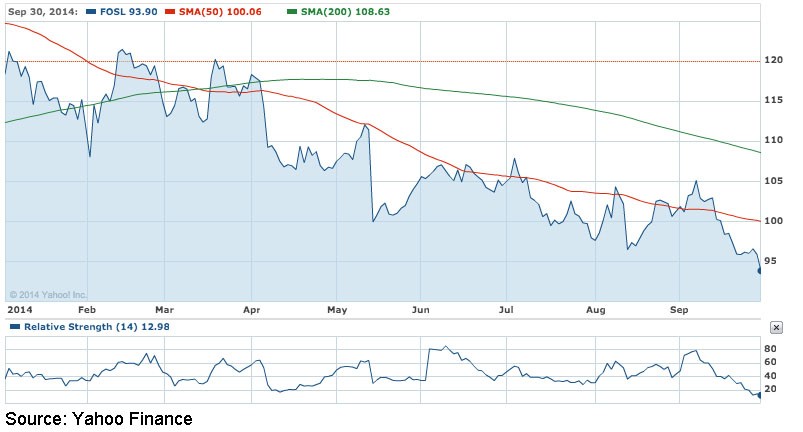4 Signs Its Time To Sell A Stock
Post on: 16 Март, 2015 No Comment

The market always crashes in September
By Jean Chatzky
The stock market has been hovering near new highs, lifting all boats.
These welcome rises also can trigger portfolio-balancing warning signs for investors, as some stocks rise while others languish. After all, the Standard & Poor’s 500 index is up 20 percent in the past year, and the current price-earnings ratio for the S&P 500 is 19.57, compared with 14.56 historically.
The result is that you may need to think about selling some of your stocks, which can be harder than buying them.
Investors should take another look at their portfolios these days, says Lock Bingham, a financial adviser at Stifel Financial Corp. in San Francisco. Some stocks may have gone up significantly, he says, and they may be higher portions of your stock holdings.
Take emotion out
The key is taking the emotion out of the investment process, adds Amy Rose Herrick, a chartered financial consultant in the U.S. Virgin Islands. No stock can love you because they’re merely investment tools, she says. So, it’s important to set key profit and loss limits on a stock. Too much greed or pride can cost you, she says.
Here are four guidelines to help you decide whether to sell or hold your stocks.
1. Some stocks begin overtaking your portfolio. Any time a stock comprises 5 percent to 10 percent of your portfolio’s value, look to see if it still fits, Bingham says. Stocks that have risen so fast that they’re now over 10 percent of a portfolio should be gradually pared back.
Never sell one stock all at once, however, he says. Sell a little at a time and buy a little at a time.
Anthony Kure, a fee-only investment adviser in Ohio, agrees. Pare back winners, including employer stock, he says. Sticking with your long-term investment plan allocation is the key to success. That means using preset guidelines for holding, say, consumer-staple stocks that may comprise 20 percent of an equity portfolio.
This way, you reduce the risk of being overexposed in one sector, he says.
2. Company fundamentals change. Crumbling company financials, especially revenue and earnings growth, can spell trouble for a company. These financials can change for many reasons, including losing competitive advantages or changing managers.
One major technology firm is a good example here, Bingham says. Company revenues have slowed and gross profits, which measure the cost of generating those revenues, have declined. On the plus side, the company had a huge cash hoard and fair dividend at the end of its most recent quarter.
Given these fundamental shifts, that stock might now better suit investors gunning for income, not growth, Bingham says.
Xavier Epps, a Washington, D.C.-based financial adviser, advises investors to especially monitor company earnings slumps. Did the company sell a division? Are earnings cyclical, such as with mining companies? Looking at income statements can give investors some insight, he says.
If management can’t explain earnings declines, reconsider the stock, Epps says. All CEOs know that Wall Street is looking at earnings.
More On Investing:
investing
Epps recommends avoiding stocks that have sudden run-ups, looking instead for consistent earnings. Even in economic uncertainty these stocks perform well, he says.
3. Stock price exceeds future growth. To scrutinize a company’s growth outlook, check out forward-looking earnings estimates that are issued by analysts, says Kure, a former equity analyst. They’re usually called consensus earnings estimates and are issued by as many as 40 analysts. They can be found on various financial websites.
Analysts’ estimates that have headed downward for the past several quarters are a bad sign for a stock, Kure says. The reason: Crumbling estimates can drag down stock growth for a while. According to the American Association of Individual Investors, stocks with negative earnings surprises have below-average stock performance for as long as one year. This is called the cockroach effect, where one-quarter of earnings surprises is often followed by several others, says the Association.
For example, after one company announced that its 2014 earnings would be below analysts’ estimates, the stock sank. And it’s risen only 1.9 percent so far this year. When revisions are sharp, do some more homework so you can find out what has changed at the company, Kure says. Be especially vigilant with fast-moving companies.
Some stocks like Amazon.com Inc. and Twitter still haven’t logged any earnings so far. These kinds of stocks are especially risky, Kure says.
4. A stock builds a high price-to-earnings ratio. P/E ratios are good metrics for investors to follow, Bingham says. One benchmark is checking to see if a company P/E is overvalued compared with its peers. Another way is comparing the P/E with its 10-year average.
If it’s much higher, there should be a good reason, he says. When you buy a stock, you should know it backwards and forwards.
High-flying stocks also may signal that price expectations have been met, says Herrick, a financial consultant. If so, sell and take the profit, she says. This method also helps you take the emotion out of the stock transaction, she adds.
Bingham says a good rule of thumb is don’t get greedy. or irrational.
Bankrate Audio
-   View transcript Embed Audio














